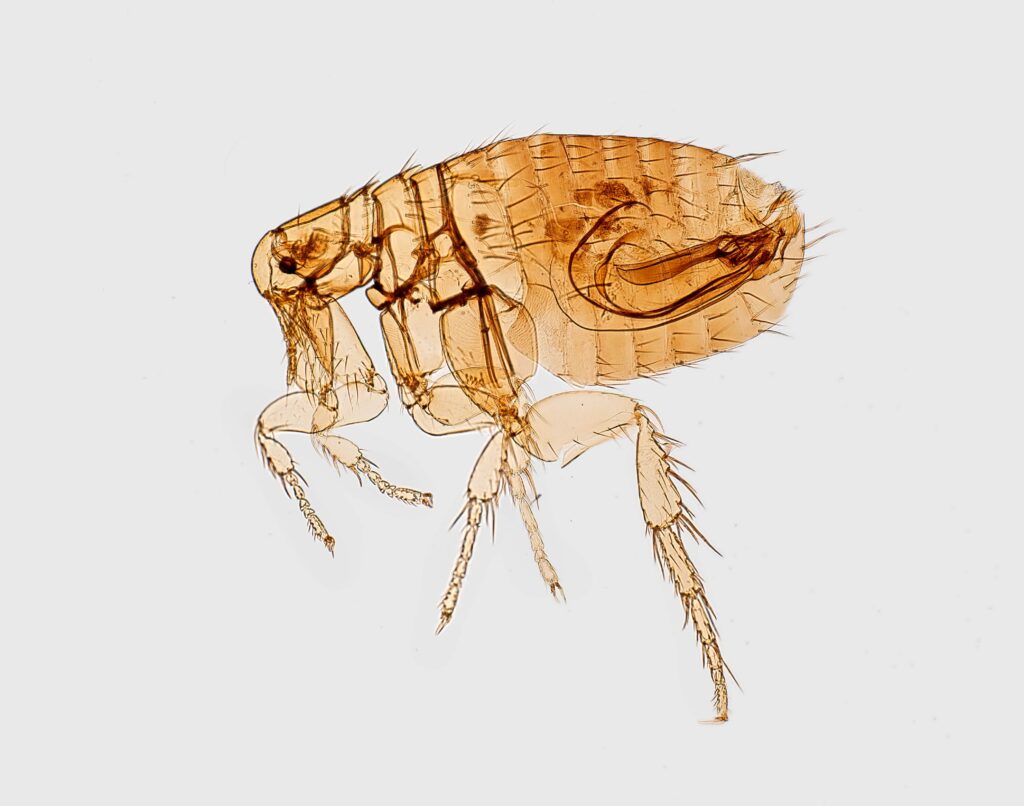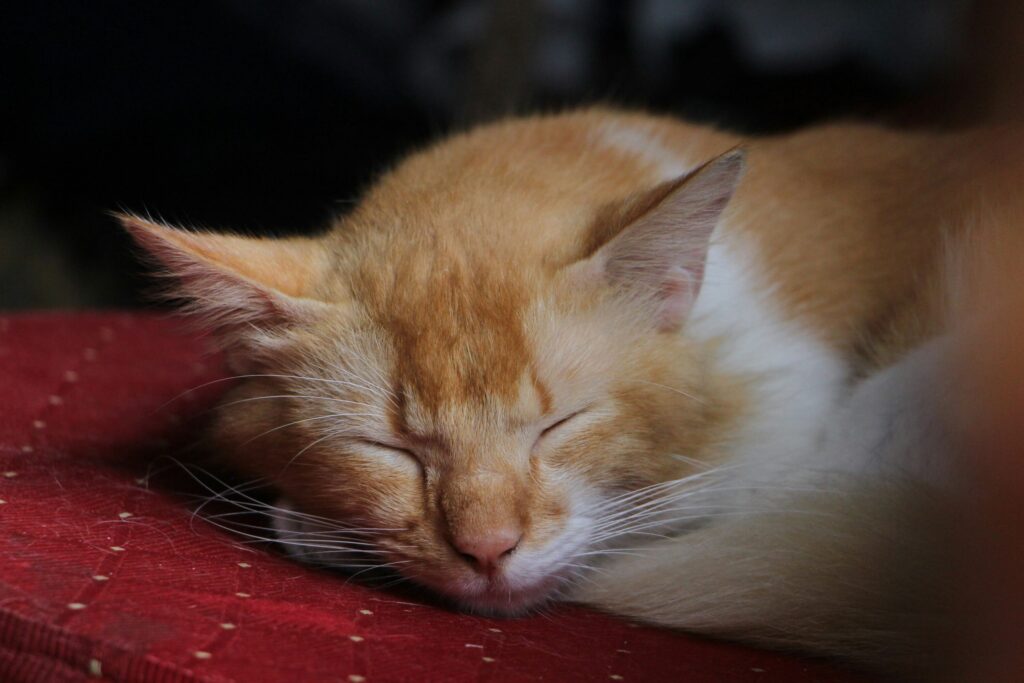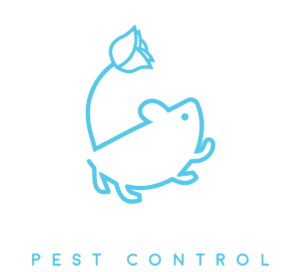Flea Control

Fleas: Uninvited, but Here to Stay
Fleas may be small, but don’t let their size fool you—they’re a major nuisance that can turn your peaceful home into a living nightmare. These tiny vampires not only infest your pets but also find comfort in carpets, furniture, and even your bedding! If you think fleas are just a pet problem, think again. They’re opportunists that can bite humans, transmit diseases, and make life at home unbearable.
Signs You Have a Flea Problem
Fleas are stealthy, but their presence is unmistakable if you know what to look for:
- Your Pets Are Scratching Like Crazy: Fleas leave pets itching and restless, especially around their neck, back, and tail areas.
- Flea Dirt: Those tiny black specks that look like dirt? That’s flea feces (blood they’ve consumed from your pet). Check pet bedding, furniture, and carpets for this telltale sign.
- Red, Irritated Bites on Your Skin: Flea bites tend to appear on ankles and legs, often in small clusters.
- Jumping Fleas: You may even spot these pests jumping around floors or furniture. Fleas are incredible jumpers, covering 7 inches vertically and 13 inches horizontally!


The Real Dangers Fleas Bring Into Your Home
Fleas aren’t just an itchy inconvenience; they pose serious health risks:
- Disease Transmission: Fleas can carry and spread harmful diseases, including typhus and cat scratch fever. Historically, fleas were responsible for the transmission of the bubonic plague.
- Allergic Reactions: Flea saliva can cause intense allergic reactions in pets and humans, leading to dermatitis and painful skin rashes.
- Tapeworm Infections: Pets that ingest fleas (usually while grooming) can become infected with tapeworms, which can also affect humans.
Flea Life Cycle & Biology
The flea’s life cycle consists of four stages: egg, larva, pupa, and adult. Under ideal conditions, this cycle can be completed in as little as two to three weeks, although it can take longer in unfavorable conditions.
- Egg Stage:
- Female fleas begin laying eggs within 24-36 hours after their first blood meal.
- Fleas can lay up to 50 eggs per day, producing several hundred eggs over their lifetime.
- Eggs are smooth and white, often falling off the host animal into carpets, bedding, and cracks in floors. Eggs usually hatch in 2-12 days, depending on environmental factors such as humidity and temperature.
- Larva Stage:
- Once hatched, flea larvae resemble tiny, legless worms with bristly hair. They are about 1/4 inch long and avoid light, preferring dark, moist areas like carpeting, upholstery, or pet bedding.
- Larvae do not feed on blood directly. Instead, they feed on organic debris, particularly the “flea dirt” (flea feces) produced by adult fleas, which consists of dried blood.
- This stage lasts for 5-11 days, during which the larvae molt twice before spinning a cocoon to enter the pupal stage.
- Pupa Stage:
- Fleas in this stage are nearly invincible.
- The larva creates a sticky cocoon where it transforms into a pupa. The pupa stage can last anywhere from 5 days to several months, depending on environmental conditions.
- The cocoon is sticky and attracts dust and debris, which helps camouflage it.
- Fleas in the pupal stage wait for signals of a potential host, such as vibrations, heat, or carbon dioxide, before emerging as adults. This ability to delay emergence allows fleas to survive in the environment for extended periods.
- Adult Stage:
- Once they emerge, adult fleas must find a blood meal quickly, usually within 24-48 hours, to survive and reproduce.
- Adult fleas can live for several weeks to several months, depending on conditions and the availability of a host.
- Fleas can jump over 8 inches vertically and 16 inches horizontally, helping them easily move between hosts or infest new environments.
Reproduction and Infestation
Fleas are prolific breeders, and their ability to reproduce rapidly means that an infestation can escalate quickly. A single female flea can produce thousands of offspring in her lifetime. Because the eggs, larvae, and pupae hide in the environment (like carpets and bedding) and not on the host, treating pets alone is often insufficient to eliminate an infestation.
Environmental Resilience
Fleas are incredibly resilient pests. Their ability to wait for the right moment to emerge as adults and their ability to thrive in various environments make them difficult to control. They’re well-suited for survival, even in households that are clean and well-maintained.
How Fleas Sneak Into Your Life
Fleas are notorious hitchhikers. They can enter your home in a variety of sneaky ways:
- Pets: Cats and dogs are the most common flea taxis, but fleas don’t discriminate. They’ll ride in on any furry companion.
- Wild Animals: If you have raccoons, opossums, or rodents nearby, they could be carrying fleas into your yard—and eventually into your home.
- Humans: Fleas can cling to your shoes, socks, clothing and bags and make themselves at home.

Flea-Friendly Conditions In and Around Your Home
Fleas thrive in warm, humid environments, and your home might just be a paradise for them:
- Pets’ Bedding: Fleas love cozy, warm spots where your pets sleep.
- Carpets and Rugs: These are prime flea breeding grounds, as fleas like to lay eggs in soft fibers.
- Fabric Furniture: In the creases
- Yard Debris: Piles of leaves, grass clippings, or overgrown shrubs in your yard can house wild animals—along with their flea companions.
- Humid Environments: Fleas flourish in moist areas, so homes with poor ventilation or damp basements are especially attractive to them.
7 Fascinating Flea Facts That’ll Make Your Skin Crawl
- Fleas are Olympic Jumpers: They can leap 150 times their own height, making them one of the best jumpers in the animal kingdom.
- Super Long Lifespan: A flea can live up to 100 days, and in that time, a single flea can lay up to 2,000 eggs.
- Only Adults Feed on Blood: Larvae feed on “flea dirt” (digested blood) left behind by adult fleas.
- Eggs are the Majority: Only 1-5% of the flea population is comprised of biting adults.
- Egg-Shedding Machines: A female flea can lay 40-50 eggs per day, which fall off pets and scatter all over your home.
- Cocoons of Steel: Flea pupae can remain dormant in their cocoons for months, waiting for the perfect host.
- Immune to Drowning: Fleas don’t die from being submerged in water; they can survive underwater for up to 24 hours!
Flea Control Tips for Homeowners
Ready to take the fight to these irritating invaders? Here are a few tips to control fleas:
- Vacuum Everything: Fleas love hiding in carpets, rugs, and upholstery. Vacuum thoroughly and often, especially where pets sleep. Discard vacuumed contents into triple knotted plastic bag and into exterior trash each time.
- Wash Pet Bedding: Launder your pets’ bedding in hot water weekly to kill eggs and larvae.
- Regular Pet Treatments: Use veterinarian-recommended flea treatments on your pets to keep fleas at bay.
- Yard Maintenance: Keep your yard clear of debris, mow your lawn regularly, and trim bushes to minimize flea habitats.
- Use Flea Monitors: If fleas have established themselves inside, purchase flea-specific monitors online and place them in each room thought to be a problem to monitor where they are concentrated.
- Dehumidify: Fleas hate dry environments. Invest in a dehumidifier for damp areas of your home to make it less hospitable for them.
- Have a Professional Rodent Inspection Performed: In our experience, rodents are more often than not the cause of flea issues in the home. See our pages on Rodent Control and the importance of choosing a highly thorough company with rodent specialists.
- Have Rodent Exclusion Specialists Perform Exclusion: If needed, choose only specialists for this one to eliminate and mitigate flea presence going forward. If you don’t eliminate the source, they’ll be back.

Why Fleas Are Best Left to the Professionals
Let’s be honest—fleas are relentless. They lay eggs everywhere, and their ability to hide in every nook and cranny makes them nearly impossible to eliminate without professional help. While DIY treatments may temporarily reduce flea populations, they rarely address the root of the problem.
At Pasadena Pest Control, we understand the importance of understanding the intersections of fleas, pets, humans, wildlife and the terrain. We use detailed inspections and eco-conscious, and integrated approaches that eliminate fleas at all life stages—eggs, larvae, pupae, and adults. Our trained experts know exactly where to target to ensure your home is flea-free, so you can get back to living itch-free. We’re well trained for both interior and exterior control.
Safety First
“Is it Safe?”
At Pasadena Pest Control, we keep the safety of your family and pets at the forefront of our minds as we plan and work, doing so with minimal disruption to your daily life. We apply chemicals according to the label, which in California is among the strictest and safest in the nation. We take into account your pets and plants, your family and the features specific to your property. At Pasadena Pest Control, we are well-trained on safety procedures, eco-consciousness and educating our customers. And yes, we are licensed, bonded and insured.
When you work with us, you will always know what to expect, how to be prepared, when we are coming, when we’ve started and when we’re done. In short, we provide The Service We’d Want in Your Shoes.

Don’t Let Fleas Bleed You Dry! Call Pasadena Pest Control Today!
Ready to send fleas packing? What are you waiting for? Let’s make your home flea-free and fabulous!
Questions Others are asking
We ❤️ love helping new customers! Don’t see your question answered below? Call us and we’ll
be happy to provide more information.
be happy to provide more information.
They often hitch a ride on pets or wildlife and can infest homes if not controlled.
Fleas can transmit diseases and cause allergic reactions in both humans and pets.
Regularly vacuum, wash pet bedding, and treat pets with veterinarian-recommended flea control products.
